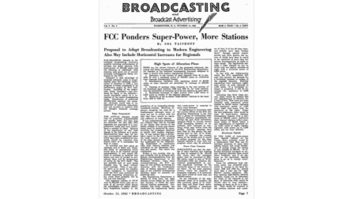
In many parts of the world, FM is still the next bright thing. Representing the newest digital radio standard, DRM, I often hear that “digitizing radio is not an imperative,” that “there is no new compelling business model for digital radio” or that “there are not enough, cheap receivers.”
And who can argue that FM still works very well worldwide and the receivers are cheap and aplenty? FM, a very robust global standard, was born almost a century ago and was ignored for a long time. To start with receivers were not that many or that cheap! FM really took off in the 1970s, delivering good sounding music, mainly to its avid audiences.
The recent revival of radio in a country like India, for example, can be attributed to the new FM commercial stations. Even the mighty Apple thinks that in our digital age “we need more than algorithms, we need programming with a human touch!” Ah, radio then! But not the Internet or pay radio, just smarter digital radio.
Why? Because FM radio expansion is becoming constrained by an increasing lack of available spectrum. FM is also limited in its coverage, programs and services for the listeners.
FM is a very energy hungry beast, too.
It has been reliably calculated that to cover an area of approximately 235,000 square kilometers (an area of about 600 kilometers in diameter), you would need at least 15 FM transmitters of 10 kW or more delivering one single program. A DRM medium wave transmitter (of 100 kW analog or 40–50kW DRM power) can do the same, offering the same coverage with the same audio quality — if not better, since of course it’s digital — using about one third of the power guzzled by FM.
So we consume 50 kW and broadcast three programs covering about a quarter of a million square kilometers in digital instead of using 15 FM transmitters to deliver one program. So is FM bad? Not at all. But FM is a local solution with limited coverage that has outgrown its potential.
The spectrum and energy arguments might be boring but they are demonstrable. Take the energy savings and invest in content and multistandard receiver creation!
And let me share one more secret with you: if you cannot grow FM and renew it, eventually its reach and the generated revenue will tail off. Research shows that in the United Kingdom a typical AM/FM listener listens to 2.9 stations a week. With the addition of digital radio that goes up to 3.5. More content, more services, more choice and more revenue.
And what about the receivers? They follow good, intelligent content, enhanced by valuable “human touch.” Changing from FM to digital is no mean feat. The FM spectrum (like the AM spectrum) has no inherent value for telcos today. Used digitally, the same spectrum can accommodate many more channels, players and increased choice for digital listeners, potentially delivering more revenue.
Change costs money, it needs support, coordination and excellent communication. Don’t let FM be the shorthand for “no change.” Maybe listeners are more up for the digital change than a lot of us think.
Digital radio is still in its infancy; give it a bit more time, financial support and a chance to grow!
Ruxandra Obreja is the head of Digital Radio Development in the BBC World Service Group and chairman of Digital Radio Mondiale.









